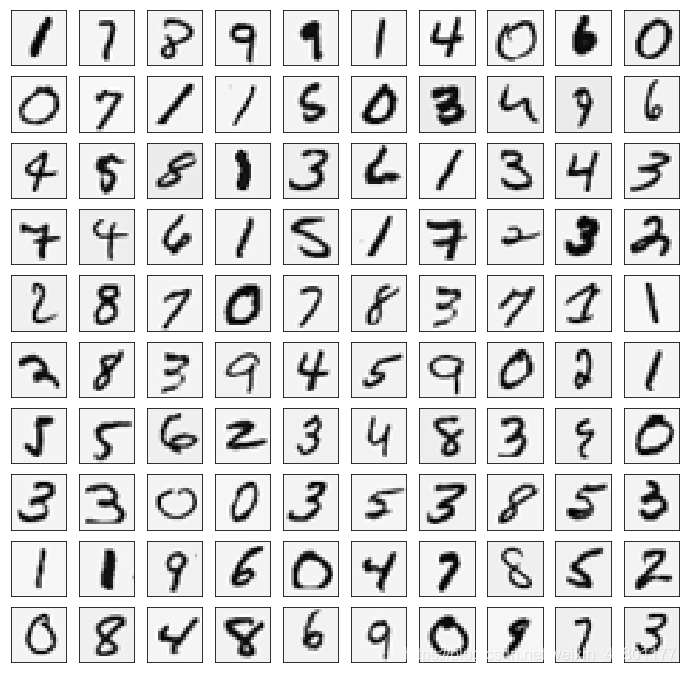吴恩达机器学习ex3 python实现
多分类
这个部分需要你实现手写数字(0到9)的识别。你需要扩展之前的逻辑回归,并将其应用于一对多的分类。
数据集
这是一个MATLAB格式的.m文件,其中包含5000个20*20像素的手写字体图像,以及他对应的数字。另外,数字0的y值,对应的是10
用Python读取我们需要使用SciPy
import numpy as np
import pandas as pd
import matplotlib.pyplot as plt
import matplotlib
from scipy.io import loadmat
from sklearn.metrics import classification_report
data = loadmat('ex3data1.mat')
data
{'X': array([[0., 0., 0., ..., 0., 0., 0.],
[0., 0., 0., ..., 0., 0., 0.],
[0., 0., 0., ..., 0., 0., 0.],
...,
[0., 0., 0., ..., 0., 0., 0.],
[0., 0., 0., ..., 0., 0., 0.],
[0., 0., 0., ..., 0., 0., 0.]]),
'__globals__': [],
'__header__': b'MATLAB 5.0 MAT-file, Platform: GLNXA64, Created on: Sun Oct 16 13:09:09 2011',
'__version__': '1.0',
'y': array([[10],
[10],
[10],
...,
[ 9],
[ 9],
[ 9]], dtype=uint8)}
data['X'].shape ,data['y'].shape
((5000, 400), (5000, 1))
数据可视化
随机展示100个数据
sample_idx = np.random.choice(np.arange(data['X'].shape[0]),100)
sample_images = data['X'][sample_idx,:]
sample_images
array([[0., 0., 0., ..., 0., 0., 0.],
[0., 0., 0., ..., 0., 0., 0.],
[0., 0., 0., ..., 0., 0., 0.],
...,
[0., 0., 0., ..., 0., 0., 0.],
[0., 0., 0., ..., 0., 0., 0.],
[0., 0., 0., ..., 0., 0., 0.]])
fig,ax_array = plt.subplots(nrows=10,ncols=10,sharey=True,sharex=True,figsize=(12,12))
for r in range(10):
for c in range(10):
ax_array[r,c].matshow(np.array(sample_images[10*r+c].reshape((20,20))).T,cmap=matplotlib.cm.binary)
plt.xticks(np.array([]))
plt.yticks(np.array([]))
将逻辑回归向量化
你将用多分类逻辑回归做一个分类器。因为现在有10个数字类别,所以你需要训练10个不同的逻辑回归分类器。为了让训练效率更高,将逻辑回归向量化是非常重要的,不要用循环。
向量化代价函数J( θ \theta θ)
def sigmoid(z):
return 1/(1+np.exp(-z))
#向量化代价函数
def cost(theta,X,y,learningRate):
theta = np.matrix(theta)
X = np.matrix(X)
y = np.matrix(y)
left = np.multiply(-y,np.log(sigmoid(X*theta.T)))
right = np.multiply((1-y),np.log(1-sigmoid(X*theta.T)))
reg = (learningRate/(2*len(X)))*np.sum(np.power(theta[:,1:theta.shape[1]],2))
return np.sum(left-right)/len(X) + reg
向量化正则化逻辑回归
#向量化梯度函数
def gradient(theta,X,y,learningRate):
theta = np.matrix(theta)
X = np.matrix(X)
y = np.matrix(y)
parameters = int(theta.ravel().shape[1])
error = sigmoid(X*theta.T) - y
grad = ((X.T * error)/len(X)).T + ((learningRate/len(X))*theta)
grad[0,0] = np.sum(np.multiply(error,X[:,0]))/len(X)
return np.array(grad).ravel()
一对多分类器
现在我们已经定义了代价函数和梯度函数,现在是构建分类器的时候了。
对于这个任务,我们有10个可能的类,并且由于逻辑回归只能一次在2个类之间进行分类,我们需要多类分类的策略。
在本练习中,我们的任务是实现一对一全分类方法,其中具有k个不同类的标签就有k个分类器,每个分类器在“类别 i”和“不是 i”之间决定。
我们将把分类器训练包含在一个函数中,该函数计算10个分类器中的每个分类器的最终权重,并将权重返回为k*(n + 1)数组,其中n是参数数量。
from scipy.optimize import minimize
#单层网络模型
def one_vs_all(X,y,num_labels,learning_rate):
rows = X.shape[0]
params = X.shape[1]
#k*(n+1) 的array,用于储存每个k分类器的参数
all_theta = np.zeros((num_labels,params+1))
#插入一列1
X = np.insert(X,0,values=np.ones(rows),axis=1)
#labels都是以1开始索引的,不是从0
for i in range(1,num_labels+1):
theta = np.zeros(params+1)
#相当于新建一个二分类器的数据,输入不变,输出变为是否为i的二分类
y_i = np.array([1 if label == i else 0 for label in y])
y_i = np.reshape(y_i,(rows,1))
#最优化代价函数
fmin = minimize(fun = cost, x0 = theta,args = (X,y_i,learning_rate),method = 'TNC',jac = gradient)
all_theta[i-1,:] = fmin.x
return all_theta
这里需要注意的几点:首先,我们为theta添加了一个额外的参数(与训练数据一列),以计算截距项(常数项)。 其次,我们将y从类标签转换为每个分类器的二进制值(要么是类i,要么不是类i)。 最后,我们使用SciPy的较新优化API来最小化每个分类器的代价函数。 如果指定的话,API将采用目标函数,初始参数集,优化方法和jacobian(渐变)函数。 然后将优化程序找到的参数分配给参数数组。
实现向量化代码的一个更具挑战性的部分是正确地写入所有的矩阵,保证维度正确。
rows = data['X'].shape[0]
params = data['X'].shape[1]
all_theta = np.zeros((10,params + 1))
X = np.insert(data['X'],0,values=np.ones(rows),axis=1)
theta = np.zeros(params+1)
y_0 = np.array([1 if label == 0 else 0 for label in data['y']])
y_0 = np.reshape(y_0,(rows,1))
X.shape,y_0.shape,theta.shape,all_theta.shape
((5000, 401), (5000, 1), (401,), (10, 401))
注意,theta是一维数组,因此当它被转换为计算梯度的代码中的矩阵时,它变为(1×401)矩阵。 我们还检查y中的类标签,以确保它们看起来像我们想象的一致。
#查看y中有几类
np.unique(data['y'])
array([ 1, 2, 3, 4, 5, 6, 7, 8, 9, 10], dtype=uint8)
all_theta = one_vs_all(data['X'],data['y'],10,1)
all_theta
array([[-2.38254176e+00, 0.00000000e+00, 0.00000000e+00, ...,
1.30426303e-03, -7.17245139e-10, 0.00000000e+00],
[-3.18255097e+00, 0.00000000e+00, 0.00000000e+00, ...,
4.46037881e-03, -5.08528248e-04, 0.00000000e+00],
[-4.79725016e+00, 0.00000000e+00, 0.00000000e+00, ...,
-2.87026543e-05, -2.47433759e-07, 0.00000000e+00],
...,
[-7.98553657e+00, 0.00000000e+00, 0.00000000e+00, ...,
-8.95420362e-05, 7.21788914e-06, 0.00000000e+00],
[-4.57378972e+00, 0.00000000e+00, 0.00000000e+00, ...,
-1.33558726e-03, 9.98591236e-05, 0.00000000e+00],
[-5.40484816e+00, 0.00000000e+00, 0.00000000e+00, ...,
-1.16513518e-04, 7.86318240e-06, 0.00000000e+00]])
一对多预测
我们现在准备好最后一步 - 使用训练完毕的分类器预测每个图像的标签。 对于这一步,我们将计算每个类的类概率,对于每个训练样本(使用当然的向量化代码),并将输出类标签为具有最高概率的类。
def predict_all(X,all_theta):
rows = X.shape[0]
params = X.shape[1]
num_labels = all_theta.shape[0]
#插入常数项1
X = np.insert(X,0,values=np.ones(rows),axis=1)
X = np.matrix(X)
all_theta = np.matrix(all_theta)
#计算每个样本的分类可能性
h = sigmoid(X*all_theta.T)
#创建每个样本最大可能是的数字的array
h_argmax = np.argmax(h,axis = 1)
h_argmax = h_argmax + 1 #因为我们是以0开始的
return h_argmax
现在我们可以使用predict_all函数为每个实例生成类预测,看看我们的分类器是如何工作的。
y_pred = predict_all(data['X'],all_theta)
print(classification_report(data['y'],y_pred))
precision recall f1-score support
1 0.95 0.99 0.97 500
2 0.95 0.92 0.93 500
3 0.95 0.91 0.93 500
4 0.95 0.95 0.95 500
5 0.92 0.92 0.92 500
6 0.97 0.98 0.97 500
7 0.95 0.95 0.95 500
8 0.93 0.92 0.92 500
9 0.92 0.92 0.92 500
10 0.97 0.99 0.98 500
accuracy 0.94 5000
macro avg 0.94 0.94 0.94 5000
weighted avg 0.94 0.94 0.94 5000
神经网络
在前面一个部分,我们已经实现了多分类逻辑回归来识别手写数字。但是,逻辑回归并不能承载更复杂的假设,因为他就是个线性分类器。
这部分,你需要实现一个可以识别手写数字的神经网络。神经网络可以表示一些非线性复杂的模型。权重已经预先训练好,你的目标是在现有权重基础上,实现前馈神经网络。
模型表达
输入是图片的像素值,20*20像素的图片有400个输入层单元,不包括需要额外添加的加上常数项。
材料已经提供了训练好的神经网络的参数 Θ ( 1 ) \Theta^{{(1)}} Θ(1), Θ ( 2 ) \Theta^{{(2)}} Θ(2),有25个隐层单元和10个输出单元(10个输出)
前馈神经网络和预测
你需要实现前馈神经网络预测手写数字的功能。和之前的一对多分类一样,神经网络的预测会把 ( h θ ( x ) ) k (h_\theta(x))_k (hθ(x))k中值最大的,作为预测输出
weight = loadmat("ex3weights.mat")
theta1,theta2 = weight['Theta1'],weight['Theta2']
theta1.shape,theta2.shape
((25, 401), (10, 26))
#插入常数项
X2 = np.matrix(np.insert(data['X'],0,values=np.ones(X.shape[0]),axis=1))
y2 = np.matrix(data['y'])
X2.shape,y2.shape
((5000, 401), (5000, 1))
a1 = X2
z2 = a1*theta1.T
z2.shape
(5000, 25)
a2 = sigmoid(z2)
a2.shape
(5000, 25)
a2 = np.insert(a2,0,np.ones(a2.shape[0]),axis = 1)
z3 = a2*theta2.T
z3.shape
(5000, 10)
a3 = sigmoid(z3)
a3
matrix([[1.12661530e-04, 1.74127856e-03, 2.52696959e-03, ...,
4.01468105e-04, 6.48072305e-03, 9.95734012e-01],
[4.79026796e-04, 2.41495958e-03, 3.44755685e-03, ...,
2.39107046e-03, 1.97025086e-03, 9.95696931e-01],
[8.85702310e-05, 3.24266731e-03, 2.55419797e-02, ...,
6.22892325e-02, 5.49803551e-03, 9.28008397e-01],
...,
[5.17641791e-02, 3.81715020e-03, 2.96297510e-02, ...,
2.15667361e-03, 6.49826950e-01, 2.42384687e-05],
[8.30631310e-04, 6.22003774e-04, 3.14518512e-04, ...,
1.19366192e-02, 9.71410499e-01, 2.06173648e-04],
[4.81465717e-05, 4.58821829e-04, 2.15146201e-05, ...,
5.73434571e-03, 6.96288990e-01, 8.18576980e-02]])
y_pred2 = np.argmax(a3,axis=1) + 1
y_pred2.shape
(5000, 1)
print(classification_report(y2,y_pred2))
precision recall f1-score support
1 0.97 0.98 0.98 500
2 0.98 0.97 0.98 500
3 0.98 0.96 0.97 500
4 0.97 0.97 0.97 500
5 0.97 0.98 0.98 500
6 0.98 0.99 0.98 500
7 0.98 0.97 0.97 500
8 0.98 0.98 0.98 500
9 0.97 0.96 0.96 500
10 0.98 0.99 0.99 500
accuracy 0.98 5000
macro avg 0.98 0.98 0.98 5000
weighted avg 0.98 0.98 0.98 5000
